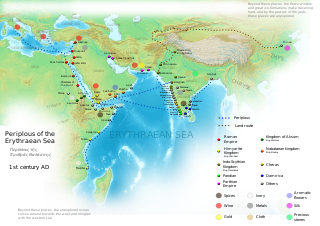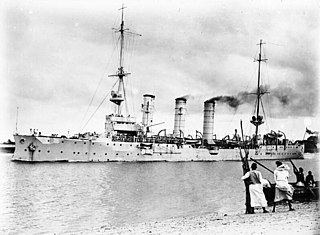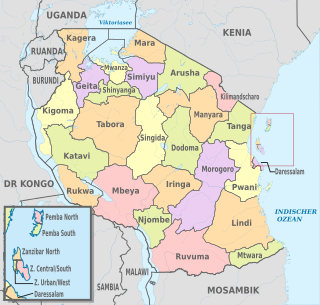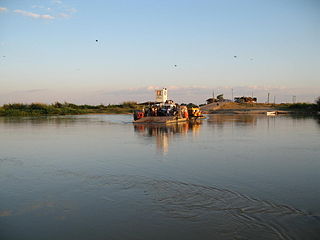
The Periplus of the Erythraean Sea, also known by its Latin name as the Periplus Maris Erythraei, is a Greco-Roman periplus written in Koine Greek that describes navigation and trading opportunities from Roman Egyptian ports like Berenice Troglodytica along the coast of the Red Sea, and others along Horn of Africa, the Persian Gulf, Arabian Sea and the Indian Ocean, including the modern-day Sindh region of Pakistan and southwestern regions of India. The text has been ascribed to different dates between the first and third centuries, but a mid-first century date is now the most commonly accepted. While the author is unknown, it is clearly a first hand description by someone familiar with the area and is nearly unique in providing accurate insights into what the ancient Hellenic world knew about the lands around the Indian Ocean.

SMS Königsberg was the lead ship of her class of light cruisers built by the German Kaiserliche Marine. Named after Königsberg, the capital of East Prussia, she was laid down in January 1905, launched in December of that year and completed by June 1906. Her class included three other ships: Stettin, Stuttgart, and Nürnberg. Königsberg was armed with a main battery of ten 10.5-centimeter (4.1 in) guns and had a top speed of 24.1 knots.
Matuumbi, also known as Kimatuumbi and Kimatumbi, is a language spoken in Tanzania in the Kipatimu region of the Kilwa District, south of the Rufiji river. It is a Bantu language, P13 in Guthrie's classification. Kimatuumbi is closely related to the Ngindo, Rufiji and Ndengereko languages. It is spoken by about 70,000 people, according to the Ethnologue.

The Rufiji River lies entirely within Tanzania. It is also the largest and longest river in the country. The river is formed by the confluence of the Kilombero and Luwegu rivers. It is approximately 600 kilometres (370 mi) long, with its source in southwestern Tanzania and its mouth on the Indian Ocean opposite Mafia Island across the Mafia Channel, in Pwani Region. Its principal tributary is the Great Ruaha River. It is navigable for approximately 100 kilometres (62 mi).

Rufiji is one of the six districts of the Pwani Region of Tanzania. It is bordered to the north by the Kisarawe and Mkuranga Districts, to the east by the Indian Ocean, to the south by the Lindi Region and to the east by the Morogoro Region.

The Selous Game Reserve is a protected area in southern Tanzania. It covers a total area of 50,000 km2 (19,000 sq mi) and has additional buffer zones. It was designated a UNESCO World Heritage Site in 1982 due to its wildlife diversity and undisturbed nature. Some of the diverse wildlife of the savannah include the presence of the African bush elephant, black rhino, hippopotamus, African Lion, East African wild dog, Cape buffaloes, Masai giraffe, Plains zebra, and Nile crocodile. Permanent human habitation is not permitted within the reserve. All human entry and exit is controlled by the Wildlife Division of the Tanzanian Ministry of Natural Resources and Tourism.
The Mafia Channel is a strait in the Pwani Region, Tanzania, Africa.
The Ndengereko are an ethnic and linguistic group from southern Pwani Region, Tanzania. Their homeland is north of the Rufiji River in parts of Mkuranga, Kisarawe and Rufiji Districts. In 2000 the Ndengereko population was estimated to number 110,000.
The Matumbi are a Bantu ethnolinguistic group based in Kilwa District, Lindi Region in southern Tanzania, who speak the Matumbi language. They are also the orig inhabitants of the Songosongo island archipelago. Their homeland is also south of the Rufiji delta in southern Pwani Region in Rufiji District. In 1978 the Matumbi population was estimated to number 72,000.

The Great Ruaha River is a river in south-central Tanzania that flows through the Usangu wetlands and the Ruaha National Park east into the Rufiji River. It traverses and marks the borders between Iringa Region, Dodoma Region and Morogoro Region. The Great Ruaha river has a basin catchment area of 83,970 square kilometres (32,421 sq mi). The population of the basin is mainly sustained by irrigation and water-related livelihoods such as fishing and livestock keeping.

The administrative divisions of Tanzania are controlled by Part I, Article 2.2 of the Constitution of Tanzania. Tanzania is divided into thirty-one regions. Each region is subdivided into districts. The districts are sub-divided into divisions and further into local wards. Wards are further subdivided for management purposes: for urban wards into streets and for rural wards into villages. The villages may be further subdivided into hamlets.

The Ulanga River, also known as the Kilombero River, rises in the highlands of the southwest of Morogoro Region, Tanzania, on the eastern slope of the East African Rift. The river flows northeast along the northeastern border of the Lindi Region before it flows into the Rufiji River. The Rufiji eventually flows into the Indian Ocean on the southern coast of the Pwani Region.
The Rufiji–Ruvuma languages are a group of Bantu languages established by Gloria Waite (1979) and subsequent researchers: N10, P10, P20.
Ndengereko, also known as Rufiji after the local river, is a Bantu language of the Matumbi hills, near Kibiti, and near Mchukivi and Bungu, Tanzania.
Nindi is a minor Bantu language of Tanzania. Classified as Bantu N.10 by Guthrie and said to be close to Ndendeule, it is presumably one of the Rufiji–Ruvuma languages with the rest of the N.10 group.

Seif Seleman Rashidi is a Tanzanian CCM politician and Member of Parliament for Rufiji constituency since 2010. He is the Minister of Health and Social Welfare.

Mkapa Bridge is the longest bridge in Tanzania across the Rufiji River. It was financed through a US$30 million loan from the Kuwait Fund, OPEC and the Government of Saudi Arabia.
Julius Nyerere Hydropower Station is a hydroelectric dam under construction across the Rufiji River in eastern Tanzania. Although controversial, the government approved the plans in 2018. The power station is expected to have an installed capacity of 2,115 megawatts (2,836,000 hp) and to produce 5,920GWh of power annually. The project, power station and dam are owned by and will be managed by the government owned Tanzania Electric Supply Company (TANESCO). Construction began in 2019 and is expected to be completed in 2022.









